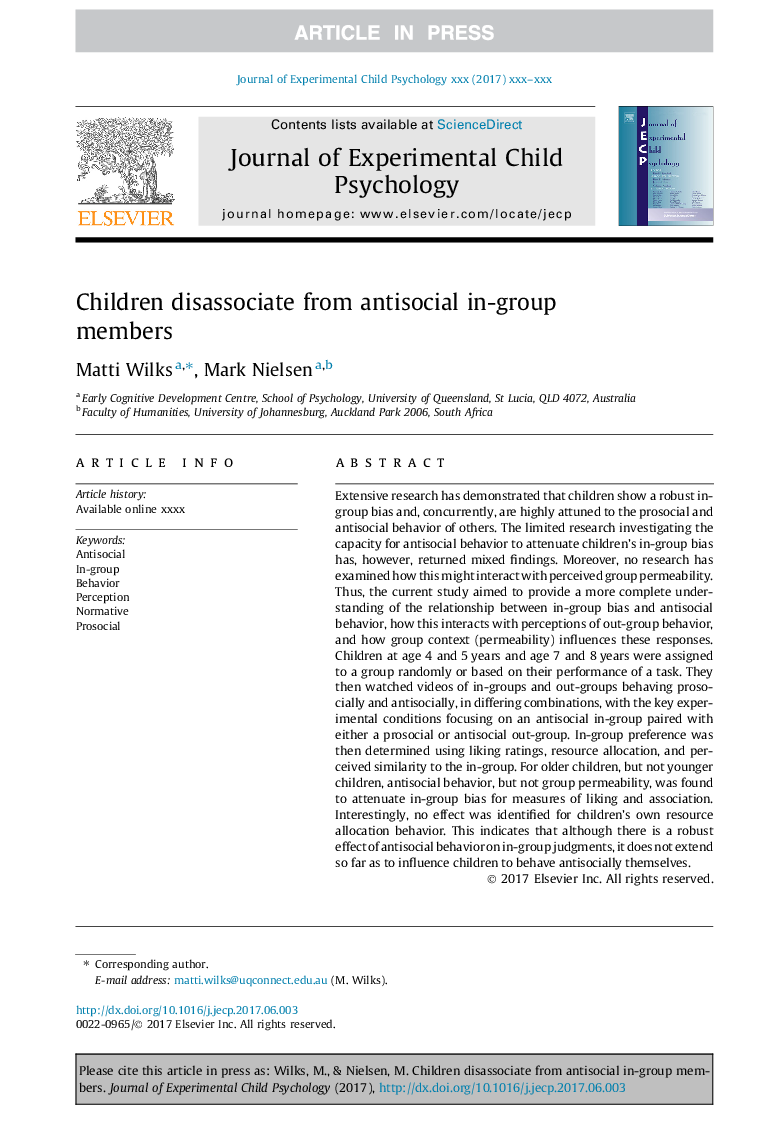| کد مقاله | کد نشریه | سال انتشار | مقاله انگلیسی | نسخه تمام متن |
|---|---|---|---|---|
| 7274323 | 1473447 | 2018 | 14 صفحه PDF | دانلود رایگان |
عنوان انگلیسی مقاله ISI
Children disassociate from antisocial in-group members
ترجمه فارسی عنوان
کودکان از اعضای گروه های غیردولتی جدا می شوند
دانلود مقاله + سفارش ترجمه
دانلود مقاله ISI انگلیسی
رایگان برای ایرانیان
کلمات کلیدی
ضد اجتماعی، در گروه، رفتار - اخلاق، ادراک، مقرراتی طرفدار
ترجمه چکیده
تحقیقات گسترده نشان داده است که کودکان با تغییرات درون گروهی مواجه هستند و در عین حال با رفتارهای غیر اخلاقی و عاطفی دیگران همخوانی دارند. با این حال، پژوهش محدود تحقیق در مورد ظرفیت رفتارهای ضد اجتماعی برای تضعیف تعصب درون گروهی کودکان، نتیجه های متفاوتی یافته است. علاوه بر این، هیچ تحقیقی در مورد چگونگی تعامل با نفوذپذیری گروه درک شده بررسی نشده است. بنابراین، مطالعه حاضر با هدف ارائه یک درک کامل از رابطه بین تعصب درون گروهی و رفتار ضد اجتماعی، چگونگی تعامل با ادراک رفتار خارج از گروه و نحوه ارتباط گروه (نفوذ پذیری) بر این پاسخ ها تاثیر می گذارد. کودکان در سن 4 و 5 سالگی یک سال و 7 سال و 8 ساله یک سال به یک گروه به طور تصادفی یا بر اساس عملکردشان به یک گروه اختصاص داده شدند. آنها سپس فیلم هایی از گروه ها و گروه های خارج را به صورت حرفه ای و ضد اجتماعی در ترکیب های مختلف تماشا می کردند و شرایط کلیدی آزمایشگاهی را با تمرکز بر یک گروه غیر انسانی در کنار یک گروه غیر رسمی یا غیر انسانی همراه می کردند. سپس ترجیحات درون گروهی با استفاده از امتیازات دلخواه، تخصیص منابع و شباهت درک شده به گروه تعیین شد. برای کودکان بزرگتر، اما نه کودکان جوانتر، رفتارهای ضد اجتماعی، اما نفوذپذیری گروهی، بر اساس تعصب درون گروهی برای اندازه گیری میل و ارتباط بود. جالب توجه است، برای رفتار تخصیص منابع شخصی کودکان تاثیری ندارد. این نشان می دهد که اگر چه اثر قوی ضد اجتماعی در قضاوت های گروهی وجود دارد، اما تا کنون تاثیری بر نفوذ فرزندان بر رفتار خود به طور انسانی ندارد.
موضوعات مرتبط
علوم انسانی و اجتماعی
روانشناسی
روانشناسی رشد و آموزشی
چکیده انگلیسی
Extensive research has demonstrated that children show a robust in-group bias and, concurrently, are highly attuned to the prosocial and antisocial behavior of others. The limited research investigating the capacity for antisocial behavior to attenuate children's in-group bias has, however, returned mixed findings. Moreover, no research has examined how this might interact with perceived group permeability. Thus, the current study aimed to provide a more complete understanding of the relationship between in-group bias and antisocial behavior, how this interacts with perceptions of out-group behavior, and how group context (permeability) influences these responses. Children at age 4 and 5Â years and age 7 and 8Â years were assigned to a group randomly or based on their performance of a task. They then watched videos of in-groups and out-groups behaving prosocially and antisocially, in differing combinations, with the key experimental conditions focusing on an antisocial in-group paired with either a prosocial or antisocial out-group. In-group preference was then determined using liking ratings, resource allocation, and perceived similarity to the in-group. For older children, but not younger children, antisocial behavior, but not group permeability, was found to attenuate in-group bias for measures of liking and association. Interestingly, no effect was identified for children's own resource allocation behavior. This indicates that although there is a robust effect of antisocial behavior on in-group judgments, it does not extend so far as to influence children to behave antisocially themselves.
ناشر
Database: Elsevier - ScienceDirect (ساینس دایرکت)
Journal: Journal of Experimental Child Psychology - Volume 165, January 2018, Pages 37-50
Journal: Journal of Experimental Child Psychology - Volume 165, January 2018, Pages 37-50
نویسندگان
Matti Wilks, Mark Nielsen,
